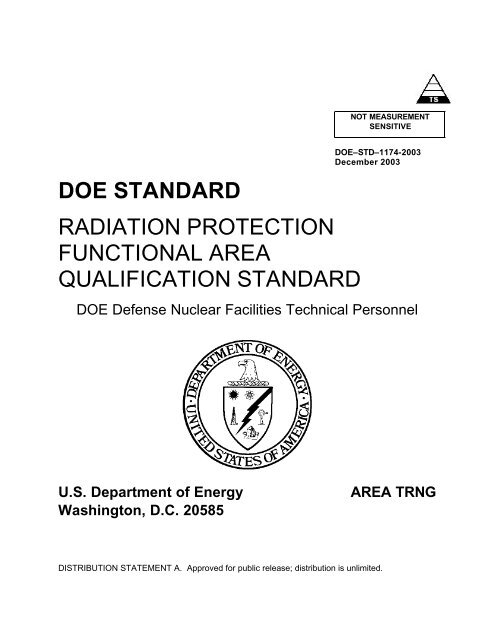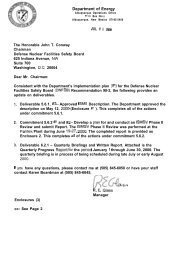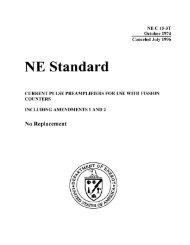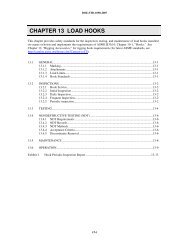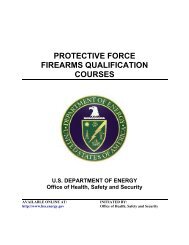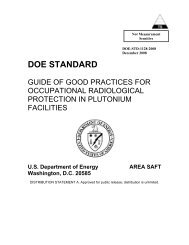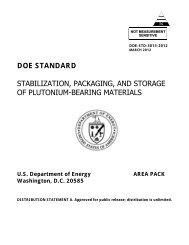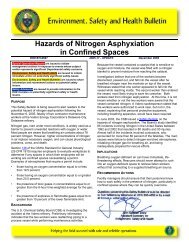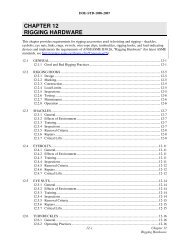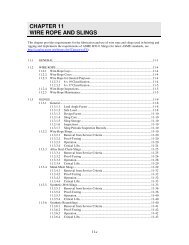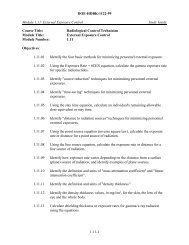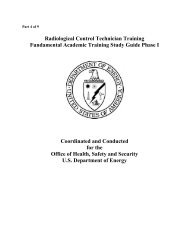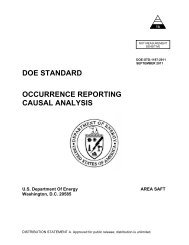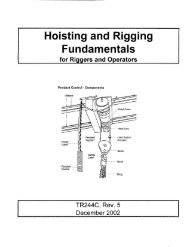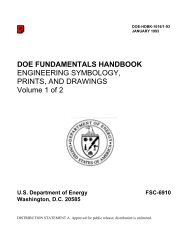DOE-STD-1174-2003 - The Office of Health, Safety and Security ...
DOE-STD-1174-2003 - The Office of Health, Safety and Security ...
DOE-STD-1174-2003 - The Office of Health, Safety and Security ...
You also want an ePaper? Increase the reach of your titles
YUMPU automatically turns print PDFs into web optimized ePapers that Google loves.
<strong>DOE</strong> STANDARD<br />
RADIATION PROTECTION<br />
FUNCTIONAL AREA<br />
QUALIFICATION STANDARD<br />
NOT MEASUREMENT<br />
SENSITIVE<br />
<strong>DOE</strong>–<strong>STD</strong>–<strong>1174</strong>-<strong>2003</strong><br />
December <strong>2003</strong><br />
<strong>DOE</strong> Defense Nuclear Facilities Technical Personnel<br />
U.S. Department <strong>of</strong> Energy AREA TRNG<br />
Washington, D.C. 20585<br />
DISTRIBUTION STATEMENT A. Approved for public release; distribution is unlimited.
This document has been reproduced directly from the best available copy.<br />
Available to <strong>DOE</strong> <strong>and</strong> <strong>DOE</strong> contractors from ES&H Technical Information Services,<br />
U.S. Department <strong>of</strong> Energy, (800) 473–4375, fax: (301) 903-9823.<br />
Available to the public from the U.S. Department <strong>of</strong> Commerce, Technology<br />
Administration, National Technical Information Service, Springfield, VA 22161;<br />
(703) 605–6000.<br />
ii
<strong>DOE</strong>-<strong>STD</strong>-<strong>1174</strong>-<strong>2003</strong><br />
APPROVAL<br />
<strong>The</strong> Federal Technical Capability Panel consists <strong>of</strong> senior U.S. Department <strong>of</strong> Energy managers<br />
responsible for overseeing the Federal Technical Capability Program. This Panel is responsible<br />
for reviewing <strong>and</strong> approving the Qualification St<strong>and</strong>ard for Department-wide application. Approval<br />
<strong>of</strong> this Qualification St<strong>and</strong>ard by the Federal Technical Capability Panel is indicated by signature<br />
below.<br />
iii<br />
l
<strong>DOE</strong>-<strong>STD</strong>-<strong>1174</strong>-<strong>2003</strong><br />
INTENTIONALLY BLANK<br />
iv
<strong>DOE</strong>-<strong>STD</strong>-<strong>1174</strong>-<strong>2003</strong><br />
TABLE OF CONTENTS<br />
ACKNOWLEDGMENT ....................................................................................................................vii<br />
PURPOSE.......................................................................................................................................1<br />
APPLICABILITY...............................................................................................................................1<br />
IMPLEMENTATION..........................................................................................................................2<br />
EVALUATION REQUIREMENTS......................................................................................................3<br />
CONTINUING EDUCATION, TRAINING, AND PROFICIENCY ...........................................................3<br />
DUTIES AND RESPONSIBILITIES....................................................................................................3<br />
BACKGROUND AND EXPERIENCE.................................................................................................4<br />
REQUIRED TECHNICAL COMPETENCIES......................................................................................4<br />
APPENDIX A, CONTINUING EDUCATION, TRAINING AND PROFICIENCY PROGRAM..................24<br />
v
<strong>DOE</strong>-<strong>STD</strong>-<strong>1174</strong>-<strong>2003</strong><br />
INTENTIONALLY BLANK<br />
vi
<strong>DOE</strong>-<strong>STD</strong>-<strong>1174</strong>-<strong>2003</strong><br />
ACKNOWLEDGMENT<br />
<strong>The</strong> <strong>Office</strong> <strong>of</strong> Environment, <strong>Safety</strong> <strong>and</strong> <strong>Health</strong> is the Sponsor for the Radiation Protection<br />
Qualification St<strong>and</strong>ard. <strong>The</strong> Sponsor is responsible for coordinating the development <strong>and</strong>/or<br />
review <strong>of</strong> the Functional Area Qualification St<strong>and</strong>ard by subject matter experts to ensure that the<br />
technical content <strong>of</strong> the st<strong>and</strong>ard is accurate <strong>and</strong> adequate for Department-wide application for<br />
those involved in the Radiation Protection Program. <strong>The</strong> Sponsor, in coordination with the Federal<br />
Technical Capability Panel, is also responsible for ensuring that the Functional Area Qualification<br />
St<strong>and</strong>ard is maintained current.<br />
<strong>The</strong> following subject matter experts (SMEs) participated in the development <strong>and</strong>/or review <strong>of</strong> this<br />
Qualification St<strong>and</strong>ard:<br />
Peter O’Connell <strong>Office</strong> <strong>of</strong> Environment, <strong>Safety</strong> <strong>and</strong> <strong>Health</strong><br />
John Connelly <strong>Office</strong> <strong>of</strong> Environment, <strong>Safety</strong> <strong>and</strong> <strong>Health</strong><br />
vii
<strong>DOE</strong>-<strong>STD</strong>-<strong>1174</strong>-<strong>2003</strong><br />
INTENTIONALLY BLANK<br />
viii
Radiation Protection<br />
PURPOSE<br />
<strong>DOE</strong>-<strong>STD</strong>-<strong>1174</strong>-<strong>2003</strong><br />
U.S. DEPARTMENT OF ENERGY<br />
FUNCTIONAL AREA QUALIFICATION STANDARD<br />
<strong>DOE</strong> M 426.1-1, Federal Technical Capability Manual, commits the Department to continuously<br />
strive for technical excellence. <strong>The</strong> Technical Qualification Program, along with the supporting<br />
Technical Qualification St<strong>and</strong>ards, complements the personnel processes that support the<br />
Department's drive for technical excellence. In support <strong>of</strong> this goal, the competency requirements<br />
defined in the Technical Qualification St<strong>and</strong>ards should be aligned with <strong>and</strong> integrated into the<br />
recruitment <strong>and</strong> staffing processes for technical positions. <strong>The</strong> Technical Qualification St<strong>and</strong>ards<br />
should form the primary basis for developing vacancy announcements, qualification requirements,<br />
crediting plans, interviewing questions, <strong>and</strong> other criteria associated with the recruitment, selection,<br />
<strong>and</strong> internal placement <strong>of</strong> technical personnel. <strong>Office</strong> <strong>of</strong> Personnel Management minimum<br />
qualifications st<strong>and</strong>ards will be greatly enhanced by application <strong>of</strong> appropriate materials from the<br />
technical Functional Area Qualification St<strong>and</strong>ards.<br />
<strong>The</strong> Technical Qualification St<strong>and</strong>ards are not intended to replace the OPM Qualifications<br />
St<strong>and</strong>ards nor other Departmental personnel st<strong>and</strong>ards, rules, plans, or processes. <strong>The</strong> primary<br />
purpose <strong>of</strong> the Technical Qualification Program is to ensure that employees have the requisite<br />
technical competency to support the mission <strong>of</strong> the Department. <strong>The</strong> Technical Qualification<br />
Program forms the basis for the development <strong>and</strong> assignment <strong>of</strong> <strong>DOE</strong> personnel responsible for<br />
ensuring the safe operation <strong>of</strong> defense nuclear facilities.<br />
APPLICABILITY<br />
<strong>The</strong> Radiation Protection Functional Area Qualification St<strong>and</strong>ard establishes common functional<br />
area competency requirements for Department <strong>of</strong> Energy personnel who provide assistance,<br />
direction, guidance, oversight, or evaluation <strong>of</strong> contractor technical activities that could impact the<br />
safe operation <strong>of</strong> <strong>DOE</strong>’s defense nuclear facilities. <strong>The</strong> technical Functional Area Qualification<br />
St<strong>and</strong>ard has been developed as a tool to assist <strong>DOE</strong> Program <strong>and</strong> Field <strong>of</strong>fices in the<br />
development <strong>and</strong> implementation <strong>of</strong> the Technical Qualification Program in their organization. For<br />
ease <strong>of</strong> transportability <strong>of</strong> qualifications between <strong>DOE</strong> elements, Program <strong>and</strong> Field <strong>of</strong>fices are<br />
expected to use this technical Functional Area Qualification St<strong>and</strong>ard without modification or<br />
additions. Needed additional <strong>of</strong>fice/site/facility specific technical competencies should be h<strong>and</strong>led<br />
separately. Satisfactory <strong>and</strong> documented attainment <strong>of</strong> the competency requirements contained in<br />
this technical Functional Area Qualification St<strong>and</strong>ard ensures that personnel possess the requisite<br />
competence to fulfill their functional area duties <strong>and</strong> responsibilities. <strong>Office</strong>/Facility-Specific<br />
Qualification St<strong>and</strong>ards supplement this technical Functional Area Qualification St<strong>and</strong>ard <strong>and</strong><br />
establish unique operational competency requirements at the Headquarters or Field element, site,<br />
or facility level.<br />
1
IMPLEMENTATION<br />
<strong>DOE</strong>-<strong>STD</strong>-<strong>1174</strong>-<strong>2003</strong><br />
This technical Functional Area Qualification St<strong>and</strong>ard identifies the minimum technical competency<br />
requirements for Department <strong>of</strong> Energy personnel. Although there are other competency<br />
requirements associated with the positions held by <strong>DOE</strong> personnel, this Functional Area<br />
Qualification St<strong>and</strong>ard is limited to identifying the specific technical competencies. <strong>The</strong><br />
competency statements define the expected knowledge <strong>and</strong>/or skill that an individual must meet.<br />
Each <strong>of</strong> the competency statements is further explained by a listing <strong>of</strong> supporting knowledge <strong>and</strong>/or<br />
skill statements.<br />
<strong>The</strong> competencies identify a familiarity level, a working level, or an expert level <strong>of</strong> knowledge; or<br />
they require the individual to demonstrate the ability to perform a task or activity. <strong>The</strong>se levels are<br />
defined as follows:<br />
Familiarity level is defined as basic knowledge <strong>of</strong> or exposure to the subject or process<br />
adequate to discuss the subject or process with individuals <strong>of</strong> greater knowledge.<br />
Working level is defined as the knowledge required to monitor <strong>and</strong> assess<br />
operations/activities, to apply st<strong>and</strong>ards <strong>of</strong> acceptable performance, <strong>and</strong> to reference<br />
appropriate materials <strong>and</strong>/or expert advice as required to ensure the safety <strong>of</strong> Departmental<br />
activities.<br />
Expert level is defined as a comprehensive, intensive knowledge <strong>of</strong> the subject or process<br />
sufficient to provide advice in the absence <strong>of</strong> procedural guidance.<br />
Demonstrate the ability is defined as the actual performance <strong>of</strong> a task or activity in<br />
accordance with policy, procedures, guidelines, <strong>and</strong>/or accepted industry or Department<br />
practices.<br />
Headquarters <strong>and</strong> Field elements shall establish a program <strong>and</strong> process to ensure that <strong>DOE</strong><br />
personnel possess the competencies required <strong>of</strong> their position. That includes the competencies<br />
identified in this technical Functional Area Qualification St<strong>and</strong>ard. Documentation <strong>of</strong> the<br />
completion <strong>of</strong> the requirements <strong>of</strong> the St<strong>and</strong>ard shall be included in the employee's training <strong>and</strong><br />
qualification record.<br />
Equivalencies should be used sparingly <strong>and</strong> with the utmost rigor <strong>and</strong> scrutiny to maintain the spirit<br />
<strong>and</strong> intent <strong>of</strong> the TQP. Equivalencies may be granted for individual competencies based upon<br />
objective evidence <strong>of</strong> previous education, training, certification, or experience. Objective evidence<br />
includes a combination <strong>of</strong> transcripts, certifications, <strong>and</strong>, in some cases, a knowledge sampling<br />
through a written <strong>and</strong>/or oral examination. Equivalencies shall be granted in accordance with the<br />
Technical Qualification Program Plan <strong>of</strong> the <strong>of</strong>fice qualifying the individual. <strong>The</strong> supporting<br />
knowledge <strong>and</strong>/or skill statements, while not requirements, should be considered before granting<br />
equivalency for a competency.<br />
Training shall be provided to employees in the Technical Qualification Program who do not meet<br />
the competencies contained in the technical Functional Area Qualification St<strong>and</strong>ard. Training may<br />
include, but is not limited to, formal classroom <strong>and</strong> computer based courses, self-study, mentoring,<br />
on the job training, <strong>and</strong> special assignments. Departmental training will be based upon appropriate<br />
supporting knowledge <strong>and</strong>/or skill statements similar to the ones listed for each <strong>of</strong> the competency<br />
statements. Headquarters <strong>and</strong> Field elements should use the supporting knowledge <strong>and</strong>/or skill<br />
statements as a basis for evaluating the content <strong>of</strong> any training used to provide individuals with the<br />
requisite knowledge <strong>and</strong>/or skill required to meet the technical Functional Area Qualification<br />
St<strong>and</strong>ard competency statements.<br />
2
EVALUATION REQUIREMENTS<br />
<strong>DOE</strong>-<strong>STD</strong>-<strong>1174</strong>-<strong>2003</strong><br />
Attainment <strong>of</strong> the competencies listed in this technical Functional Area Qualification St<strong>and</strong>ard<br />
should be documented by a qualifying <strong>of</strong>ficial, immediate supervisor, or the team leader <strong>of</strong><br />
personnel in accordance with the Technical Qualification Program Plan <strong>of</strong> the <strong>of</strong>fice qualifying the<br />
individual.<br />
CONTINUING EDUCATION, TRAINING, AND PROFICIENCY<br />
<strong>DOE</strong> personnel shall participate in continuing education <strong>and</strong> training as necessary to improve their<br />
performance <strong>and</strong> pr<strong>of</strong>iciency <strong>and</strong> ensure that they stay up-to-date on changing technology <strong>and</strong><br />
new requirements. This may include courses <strong>and</strong>/or training provided by:<br />
• Department <strong>of</strong> Energy<br />
• Other government agencies<br />
• Outside vendors<br />
• Educational institutions<br />
Beyond formal classroom or computer based courses, continuing training may include<br />
• Self Study<br />
• Attendance at symposia, seminars, exhibitions<br />
• Special assignments<br />
• On-the-job experience<br />
A description <strong>of</strong> suggested learning pr<strong>of</strong>iciency activities <strong>and</strong> the requirements for the continuing<br />
education <strong>and</strong> training program for Radiation Protection personnel are included in Appendix A <strong>of</strong><br />
this document.<br />
DUTIES AND RESPONSIBILITIES<br />
<strong>The</strong> following are the typical duties <strong>and</strong> responsibilities expected <strong>of</strong> personnel assigned to the<br />
Radiation Protection Functional Area:<br />
1. Evaluates radiological protection programs to determine whether the program complies with<br />
applicable codes, st<strong>and</strong>ards, guides, regulations, Orders, <strong>and</strong> accepted practices.<br />
2. Appraises facilities, procedures, <strong>and</strong> operations to determine their adequacy to protect the<br />
workers <strong>and</strong> members <strong>of</strong> the general public from the effects <strong>of</strong> ionizing radiation.<br />
3. Administers <strong>and</strong> coordinates radiation protection program(s) for the Department, including<br />
independent evaluations <strong>and</strong> special studies.<br />
4. Provides technical assistance <strong>and</strong> advice in the area <strong>of</strong> radiation protection to other<br />
organizations <strong>and</strong> independent review groups.<br />
5. Reviews <strong>Office</strong> <strong>and</strong>/or contractor performance to identify trends indicative <strong>of</strong> performance<br />
or compliance status.<br />
6. Performs technical reviews <strong>and</strong> provides recommendations on Radiation Protection<br />
3
<strong>DOE</strong>-<strong>STD</strong>-<strong>1174</strong>-<strong>2003</strong><br />
Program documents (plans, schedules, etc.).<br />
7. Reviews <strong>and</strong> comments on a wide variety <strong>of</strong> operating contractor documents.<br />
8. Evaluates, oversees, <strong>and</strong> provides emergency preparedness <strong>and</strong> emergency response<br />
support related to radiological incidents in conjunction with contractor, Federal, State, <strong>and</strong><br />
local <strong>of</strong>ficials, as required.<br />
9. Develops, reviews <strong>and</strong> implements radiation control policy, requirements, <strong>and</strong> guidance.<br />
10. Communicates hazards associated with exposure to ionizing radiation.<br />
Position-specific duties <strong>and</strong> responsibilities for Radiation Protection personnel are contained in<br />
their <strong>Office</strong>/Facility-Specific Qualification St<strong>and</strong>ard or Position Description.<br />
BACKGROUND AND EXPERIENCE<br />
<strong>The</strong> U. S. <strong>Office</strong> <strong>of</strong> Personnel Management's Qualification St<strong>and</strong>ards H<strong>and</strong>book establishes<br />
minimum education, training, experience, or other relevant requirements applicable to a particular<br />
occupational series/grade level, as well as alternatives to meeting specified requirements.<br />
<strong>The</strong> preferred minimal education <strong>and</strong> experience for Radiation Protection personnel is:<br />
1. Education:<br />
Bachelor <strong>of</strong> Science degree in <strong>Health</strong> Physics, Radiological Science, or Nuclear<br />
Engineering, or a related physical science; or meet the alternative requirements for<br />
engineers or scientists specified in the Qualification St<strong>and</strong>ards H<strong>and</strong>book.<br />
2. Experience:<br />
Industrial, military, Federal, State, or other directly related background that has provided<br />
specialized experience in Radiation Protection. Specialized experience can be<br />
demonstrated through possession <strong>of</strong> the competencies outlined in this St<strong>and</strong>ard.<br />
In addition to the education <strong>and</strong> experience stated above, certification by the American<br />
Board <strong>of</strong> <strong>Health</strong> Physics (ABHP) is highly recommended, <strong>and</strong> typically may serve as the<br />
basis for equivalency for the competencies in the "General Technical" section <strong>of</strong> this<br />
St<strong>and</strong>ard. Successful completion <strong>of</strong> ABHP certification examination Part I or National<br />
Registry <strong>of</strong> Radiation Protection Technologists (NRRPT) certification may serve as the<br />
basis for equivalency for competencies 1-5 in the “General Technical” section <strong>of</strong> this<br />
St<strong>and</strong>ard.<br />
REQUIRED TECHNICAL COMPETENCIES<br />
<strong>The</strong> competencies contained in this St<strong>and</strong>ard are distinct from those competencies contained in<br />
the General Technical Base Qualification St<strong>and</strong>ard. Radiation Protection personnel should satisfy<br />
the competency requirements <strong>of</strong> the General Technical Base Qualification St<strong>and</strong>ard prior to or in<br />
parallel with the competency requirements contained in this St<strong>and</strong>ard. Each <strong>of</strong> the competency<br />
statements defines the level <strong>of</strong> expected knowledge <strong>and</strong> or skill that an individual must posses to<br />
meet the intent <strong>of</strong> this St<strong>and</strong>ard. <strong>The</strong> supporting knowledge <strong>and</strong>/or skill statements further<br />
describe the intent <strong>of</strong> the competency statements.<br />
4
<strong>DOE</strong>-<strong>STD</strong>-<strong>1174</strong>-<strong>2003</strong><br />
Note: When regulations, Department <strong>of</strong> Energy directives, or other industry st<strong>and</strong>ards are<br />
referenced in the Qualification St<strong>and</strong>ard, the most recent revision should be used.<br />
GENERAL TECHNICAL<br />
1. Radiation protection personnel shall demonstrate a working level knowledge <strong>of</strong><br />
the various types <strong>of</strong> radiation <strong>and</strong> how they interact with matter.<br />
Supporting Knowledge <strong>and</strong>/or Skills<br />
a. Describe each <strong>of</strong> the following forms <strong>of</strong> radiation in terms <strong>of</strong> structure, mass, origin,<br />
<strong>and</strong> electrostatic charge:<br />
• Alpha<br />
• Beta<br />
• Neutron<br />
• Gamma<br />
• X-ray<br />
b. Describe the interactions <strong>of</strong> the following with matter:<br />
• Charged particle interactions<br />
- Alpha particle<br />
- Beta particle (Positron annihilation <strong>and</strong> Bremsstrahlung)<br />
• Neutron interaction<br />
- Elastic scattering<br />
- Inelastic scattering<br />
- Fission<br />
- Capture, absorption, or activation<br />
• Photon interactions<br />
- Photoelectric effect<br />
- Compton scattering<br />
- Pair production<br />
c. Discuss the shielding materials used for each <strong>of</strong> the above types <strong>of</strong> radiation <strong>and</strong><br />
explain which are the best materials based on the interactions <strong>of</strong> radiation with<br />
matter.<br />
d. Define “range” <strong>and</strong> describe the range energy relations <strong>of</strong> charged particles<br />
including:<br />
• Factors that affect the range <strong>of</strong> charged particles<br />
• Relative range <strong>of</strong> alpha <strong>and</strong> beta in air <strong>and</strong> tissue<br />
e. Describe the attenuation <strong>of</strong> gamma <strong>and</strong> neutron radiation in shielding materials<br />
including:<br />
• Exponential attenuation<br />
• Build-up<br />
5
<strong>DOE</strong>-<strong>STD</strong>-<strong>1174</strong>-<strong>2003</strong><br />
f. Discuss radiation field characteristics for point, line, plane, <strong>and</strong> volume distributed<br />
sources.<br />
g. Describe the following particle ejection nuclear reactions <strong>and</strong> provide an example <strong>of</strong><br />
each:<br />
• Alpha, n<br />
• Gamma, n<br />
• n, Alpha<br />
2. Radiation protection personnel shall demonstrate a working level knowledge <strong>of</strong><br />
radioactivity <strong>and</strong> transformation mechanisms.<br />
Supporting Knowledge <strong>and</strong>/or Skills<br />
a. Define the following terms:<br />
• Activity<br />
• Radioactive decay constant<br />
• Curie/becquerel<br />
• Radioactive half-life<br />
• Radioactive equilibrium<br />
• Decay products<br />
• Parent nuclide<br />
• Activation<br />
• Specific activity<br />
• Naturally Occurring Radioactive Material (NORM)<br />
• Secular equilibrium<br />
• Transient equilibrium<br />
• Four factor formula<br />
b. Describe the following processes including any resulting product <strong>of</strong> decay:<br />
• Alpha decay<br />
• Beta-minus decay<br />
• Beta-plus decay<br />
• Electron capture<br />
• Isomeric transition<br />
• Internal conversion<br />
• X-ray generation<br />
c. Given the “Chart <strong>of</strong> the Nuclides,” trace the decay chain for a specified nuclide.<br />
d. Given either the half-life or the radioactive decay constant, solve radioactive decay<br />
problems.<br />
e. Using the specific activity or decay constant <strong>of</strong> an isotope, convert between mass<br />
quantities <strong>and</strong> curies.<br />
f. Convert numerical amounts <strong>of</strong> radioactivity between curie, becquerel, <strong>and</strong> dpm.<br />
3. Radiation protection personnel shall demonstrate a working level knowledge <strong>of</strong><br />
principles <strong>and</strong> concepts for internal <strong>and</strong> external dosimetry.<br />
Supporting Knowledge <strong>and</strong>/or Skills<br />
6
a. Define the following terms:<br />
<strong>DOE</strong>-<strong>STD</strong>-<strong>1174</strong>-<strong>2003</strong><br />
• Dose equivalent<br />
• Shallow dose equivalent<br />
• Deep dose equivalent<br />
• Effective dose equivalent<br />
• Committed dose equivalent<br />
• Committed effective dose equivalent<br />
• Total effective dose equivalent<br />
• Whole body<br />
• Extremity<br />
• Lens <strong>of</strong> the eye dose equivalent<br />
• Derived air concentrations (DAC)<br />
• Annual limit <strong>of</strong> intake (ALI)<br />
• Quality factor<br />
• Weighting factor<br />
• Roentgen<br />
• Rad<br />
• Rem<br />
• Sievert<br />
• Gray<br />
• Stochastic effects<br />
• Nonstochastic (deterministic) effects<br />
b. Describe the various types <strong>of</strong> bioassays, their applications <strong>and</strong> limitations.<br />
c. Discuss the methods <strong>of</strong> reducing dose from internally deposited radionuclides.<br />
d. Discuss the process used to evaluate dose based on bioassay results.<br />
e. Describe the principle <strong>of</strong> operation, proper use, placement, function, <strong>and</strong> type <strong>of</strong><br />
radiation detected by the following dose-measuring instruments:<br />
• <strong>The</strong>rmoluminescent dosimeter, including Albedo dosimeter<br />
• Pocket dosimeter (quartz fiber <strong>and</strong> electronic)<br />
• Film badge<br />
• Personnel nuclear accident dosimeter<br />
f. Discuss the concepts <strong>of</strong> International Commission on Radiological Protection (ICRP)<br />
Publications 26 <strong>and</strong> 30 as they relate to internal <strong>and</strong> external dosimetry.<br />
g. Discuss the newer concepts <strong>of</strong> ICRP Publications including; 60, 66, 68, 71, <strong>and</strong> 72<br />
<strong>and</strong> <strong>DOE</strong> Radiological Control Technical Positions (RCTP) papers, such as RCTP<br />
2000-01, as they relate to <strong>DOE</strong> requirements for internal <strong>and</strong> external dosimetry.<br />
<strong>The</strong> RCTPs are available at: http://www.eh.doe.gov/whs/rhmwp/tpp.html<br />
h. Discuss various methods used to estimate worker exposure in the absence <strong>of</strong><br />
individual monitoring results.<br />
i. Given airborne radioactivity concentration, DAC value <strong>and</strong> worker occupancy time,<br />
evaluate resulting worker dose.<br />
4. Radiation protection personnel shall demonstrate a working level knowledge <strong>of</strong><br />
the biological effects <strong>of</strong> radiation.<br />
7
Supporting Knowledge <strong>and</strong>/or Skills<br />
<strong>DOE</strong>-<strong>STD</strong>-<strong>1174</strong>-<strong>2003</strong><br />
a. Describe the effects <strong>of</strong> radiation exposure on the cellular level including:<br />
• Direct effects<br />
• Indirect effects<br />
b. Describe the factors affecting radiation sensitivity <strong>of</strong> cells (i.e., <strong>The</strong> Law <strong>of</strong> Bergonie<br />
<strong>and</strong> Tribondeau).<br />
c. Describe the acute effects <strong>and</strong> corresponding doses associated with the following:<br />
• Blood changes<br />
• Hemopoietic syndrome<br />
• Gastrointestinal syndrome<br />
• Central nervous system syndrome<br />
d. Discuss delayed effects <strong>of</strong> radiation exposure including:<br />
• Cancer induction<br />
• Genetic effects<br />
• Prenatal developmental effects<br />
• Cataracts<br />
e. Discuss how the Linear Non-threshold <strong>The</strong>ory is used in developing risk estimates<br />
<strong>and</strong> dose limits associated with exposure to radiation. (<strong>The</strong> use <strong>of</strong> International<br />
Commission on Radiological Protection (ICRP) Publications 26 <strong>and</strong> 60 or National<br />
Council on Radiation Protection <strong>and</strong> Measurements (NCRP) Report No. 116 may be<br />
helpful).<br />
5. Radiation Protection personnel shall demonstrate a working level knowledge <strong>of</strong><br />
the principles <strong>and</strong> use <strong>of</strong> radiological instrumentation <strong>and</strong> radiological<br />
monitoring/survey practices.<br />
Supporting Knowledge <strong>and</strong> Skills:<br />
a. Describe the principle <strong>of</strong> operation <strong>of</strong> gas-filled detectors.<br />
b. Discuss the following for gas-filled detectors:<br />
• Voltage-response curve (i.e., six region curve)<br />
• <strong>The</strong> three regions useful for radiation detection <strong>and</strong> measurement<br />
• <strong>The</strong> sequence <strong>of</strong> events that occur following an initial ionizing event in an<br />
Ionization Chamber, a Proportional Counter <strong>and</strong> a Geiger-Mueller Detector<br />
c. Describe the principles <strong>of</strong> operation <strong>of</strong> scintillation <strong>and</strong> solid state detectors.<br />
d. Describe the principle <strong>of</strong> operation <strong>and</strong> application <strong>of</strong> nuclear spectroscopy.<br />
e. Discuss the purpose, principles <strong>of</strong> detection <strong>and</strong> operation, <strong>and</strong> field application <strong>of</strong><br />
the following:<br />
• Continuous air monitors (CAM)<br />
• Airborne radioactivity samplers<br />
8
<strong>DOE</strong>-<strong>STD</strong>-<strong>1174</strong>-<strong>2003</strong><br />
• Area radiation monitors (ARM)<br />
• Criticality detection/alarm systems<br />
• Personnel contamination monitors<br />
• Process radiation monitors<br />
f. Discuss the basic elements <strong>and</strong> applicable st<strong>and</strong>ards <strong>of</strong> a radiological instrument<br />
calibration program, including the following:<br />
• Calibration source selection <strong>and</strong> traceability<br />
• Source check <strong>and</strong> calibration frequency<br />
• Instrument energy dependence<br />
g. Discuss the following concepts as they relate to radiological counting<br />
measurements:<br />
• Background<br />
• Lower limit <strong>of</strong> detection<br />
• Minimum detectable activity<br />
• Counting efficiency<br />
• Counting uncertainties<br />
h. Describe various radiological situations <strong>and</strong> the use <strong>of</strong> appropriate radiological<br />
surveys including: radiation, contamination, <strong>and</strong> airborne radioactivity surveys.<br />
6. Radiation protection personnel shall demonstrate a working level knowledge <strong>of</strong><br />
internal <strong>and</strong> external radiation protection principles <strong>and</strong> control techniques.<br />
Supporting Knowledge <strong>and</strong> Skills<br />
a. Discuss the implication <strong>of</strong> the following on the identification <strong>of</strong> hazards associated<br />
with radiological work activities <strong>and</strong> how it might affect the controls specified on a<br />
Radiation Work Permit (RWP):<br />
• Location <strong>of</strong> the work (i.e., in a radiation, contaminated, or airborne area)<br />
• System being worked on (i.e., fluid under pressure, hazardous or radioactive)<br />
• Nature <strong>of</strong> the work activity (inspection, opening system, etc.)<br />
b. Discuss special exposure control, survey <strong>and</strong> personnel monitoring techniques<br />
associated with work in the following areas or situations:<br />
• Non-uniform radiation fields<br />
• High radiation areas<br />
• Contact work with radioactive materials/sources<br />
c. Discuss the hierarchy <strong>of</strong> controls used to prevent uptakes <strong>of</strong> radioactive material by<br />
personnel, <strong>and</strong> potential worker hazards associated with implementation <strong>of</strong> these<br />
controls.<br />
d. For a radiological incident (i.e., spill, loss <strong>of</strong> containment), discuss the potential <strong>and</strong><br />
magnitude <strong>of</strong> the following:<br />
• Loose surface contamination levels<br />
• Airborne radioactivity levels<br />
e. Discuss appropriate personal protective equipment (including respiratory<br />
9
<strong>DOE</strong>-<strong>STD</strong>-<strong>1174</strong>-<strong>2003</strong><br />
protection) for subsequent entry into <strong>and</strong> decontamination <strong>of</strong> the above area.<br />
f. Using reference material <strong>and</strong> given the activity, calculate radiation levels from a<br />
point, line, <strong>and</strong> plane source.<br />
g. Given buildup factors <strong>and</strong> half value layers, perform shielding calculations.<br />
h. Using reference material <strong>and</strong> given a scenario including bioassay results, isotopic<br />
<strong>and</strong> chemical form etc., calculate the internal dose to be assigned to an individual.<br />
7. Radiation protection personnel shall demonstrate a working level knowledge <strong>of</strong><br />
as-low-as-reasonably-achievable (ALARA) principles, <strong>and</strong> their application to<br />
radiological work activities.<br />
Supporting Knowledge <strong>and</strong>/or Skills<br />
a. Describe the various components <strong>of</strong> an effective ALARA program including<br />
operations, engineering, <strong>and</strong> management controls.<br />
b. Describe how optimization techniques, including cost-benefit analysis, are used in<br />
the ALARA process.<br />
c. Discuss the essential elements <strong>of</strong> the job planning process <strong>and</strong> the post-job ALARA<br />
review for work performed in a radiation or radioactive contamination area.<br />
d. Describe the various radiological performance indicators that are applicable to the<br />
ALARA process.<br />
e. Calculate person-rem estimates <strong>and</strong> use the results in ALARA cost-benefit analysis.<br />
f. Discuss methods to minimize Total Effective Dose Equivalent (TEDE) by evaluating<br />
the trade-<strong>of</strong>fs in considering the internal <strong>and</strong> external dose components.<br />
g. Using knowledge <strong>of</strong> ALARA principles, discuss how to perform an evaluation <strong>of</strong> a<br />
radiation job plan <strong>and</strong> the associated worker job performance.<br />
8. Radiation protection personnel shall demonstrate a working level knowledge <strong>of</strong><br />
the application <strong>of</strong> engineered radiological controls <strong>and</strong> facility design, including<br />
containment/confinement systems.<br />
Supporting Knowledge <strong>and</strong>/or Skills<br />
a. Discuss the general principles relating to the design <strong>and</strong> installation <strong>of</strong> radiation<br />
protection containment/confinement systems including the following radiological<br />
protection considerations:<br />
• Layout design for nuclear facilities<br />
• Design <strong>and</strong> selection <strong>of</strong> components for nuclear facilities<br />
• Selection <strong>of</strong> materials <strong>and</strong> the associated surfaces for components used in<br />
radiological control areas<br />
• Design, construction, <strong>and</strong> operation <strong>of</strong> containment/confinement systems to<br />
minimize internal radiation exposure including:<br />
- Engineered ventilation<br />
- Engineered containment<br />
10
<strong>DOE</strong>-<strong>STD</strong>-<strong>1174</strong>-<strong>2003</strong><br />
- Hot cells<br />
- Radioactive liquid <strong>and</strong> solid waste processing facilities<br />
• Design, construction, <strong>and</strong> operation <strong>of</strong> systems that minimize personnel external<br />
radiation exposure including:<br />
- Shielding<br />
- Interlock systems<br />
b. Discuss the design <strong>and</strong> application <strong>of</strong> temporary engineered radiological controls.<br />
9. Radiation protection personnel shall demonstrate a familiarity level knowledge <strong>of</strong><br />
the radiological hazards associated with the following <strong>and</strong> a working level<br />
knowledge for site specific radiological hazards:<br />
• Plutonium operations<br />
• Uranium operations<br />
• Tritium operations<br />
• Nuclear explosive operations<br />
• Production/experime ntal reactors<br />
• Accelerator operations<br />
• Waste h<strong>and</strong>ling/processing operations<br />
• Decontamination <strong>and</strong> decommissioning<br />
• Use <strong>of</strong> radiation generating devices<br />
• Environmental restoration activities<br />
Supporting Knowledge <strong>and</strong>/or Skills<br />
a. Discuss the basic function <strong>and</strong> work activities associated with the above list.<br />
b. Discuss fundamental characteristics <strong>of</strong> the major radiological hazards at the above<br />
listed activities. This could include discussion <strong>of</strong>:<br />
• Mode <strong>of</strong> decay<br />
• Source<br />
• Energies <strong>of</strong> major radiations emitted<br />
• Relative principle biological hazard<br />
• Half-life<br />
c. Discuss unique radiological exposure control techniques associated with the above<br />
listed activities.<br />
REGULATORY<br />
Note: Many <strong>of</strong> the documents referenced in this Section can be obtained via the <strong>DOE</strong> ES&H<br />
home page (http://tis.eh.doe.gov/portal/home.htm) or via the Worker Protection Policy <strong>and</strong><br />
Programs home page (www.eh.doe.gov/whs/rhmwp/).<br />
11
<strong>DOE</strong>-<strong>STD</strong>-<strong>1174</strong>-<strong>2003</strong><br />
10. Radiation protection personnel shall demonstrate a expert level knowledge <strong>of</strong> the<br />
Department <strong>of</strong> Energy (<strong>DOE</strong>) radiation protection system for occupational workers<br />
as set forth in the following policy, requirements <strong>and</strong> guidance documents:<br />
• 10 CFR 835, Occupational Radiation Protection<br />
• Implementation Guidance for use with 10 CFR 835, Occupational Radiation<br />
Protection<br />
• <strong>DOE</strong> P 441.1, Department <strong>of</strong> Energy Radiological <strong>Health</strong> <strong>and</strong> <strong>Safety</strong> Policy<br />
Supporting Knowledge <strong>and</strong>/or Skills<br />
a. Discuss the relationship <strong>of</strong> the above documents in defining the <strong>DOE</strong> system <strong>of</strong><br />
radiation protection.<br />
b. Give examples <strong>of</strong> how <strong>DOE</strong> P 441.1, Department <strong>of</strong> Energy Radiological <strong>Health</strong> <strong>and</strong><br />
<strong>Safety</strong> Policy is reflected in requirements <strong>and</strong> guidance.<br />
c. Explain how the 10 CFR 835 Implementation Guides are used to develop <strong>and</strong><br />
implement local programs to comply with the radiation protection requirements at<br />
the site/facility level.<br />
d. Discuss methods <strong>of</strong> meeting the key requirements in Subpart A (General<br />
Provisions). Include:<br />
• Scope <strong>and</strong> exclusions<br />
• Definitions<br />
• Radiological units<br />
e. Discuss methods <strong>of</strong> meeting the key requirements in Subpart B (Management <strong>and</strong><br />
Administrative Requirements) based upon the guidance in the Radiation Protection<br />
Program Implementation Guide <strong>and</strong> the Occupational ALARA Program<br />
Implementation Guide, including:<br />
• Radiation Protection Program<br />
• Internal audits<br />
• Education, Training <strong>and</strong> Skills<br />
• Written Procedures<br />
f. Discuss methods <strong>of</strong> meeting the key requirements in 10 CFR 835, Subpart C<br />
(St<strong>and</strong>ards for Internal <strong>and</strong> External Exposure) based upon the guidance in the<br />
Internal Dosimetry Program Implementation Guide, the External Dosimetry Program<br />
Implementation Guide, the Radiation-Generating Devices Implementation Guide,<br />
<strong>and</strong> the Evaluation <strong>and</strong> Control <strong>of</strong> Fetal Exposure Implementation Guide, including:<br />
• Occupational Limits for general employees<br />
• Combining internal <strong>and</strong> external dose equivalents resulting from <strong>DOE</strong> activities<br />
• Determination <strong>of</strong> compliance for non-uniform exposure <strong>of</strong> the skin<br />
• Limits for the embryo/fetus<br />
• Limits for members <strong>of</strong> the public <strong>and</strong> minors entering a controlled area<br />
• Concentrations <strong>of</strong> radioactive materials in air<br />
g. Discuss methods <strong>of</strong> meeting the key requirements in 10 CFR 835, Subpart E<br />
(Monitoring <strong>of</strong> Individuals <strong>and</strong> Areas) based upon guidance in the External<br />
Dosimetry Program Implementation Guide, the Internal Dosimetry Program<br />
Implementation Guide, the Evaluation <strong>and</strong> Control <strong>of</strong> Fetal Exposure Implementation<br />
12
<strong>DOE</strong>-<strong>STD</strong>-<strong>1174</strong>-<strong>2003</strong><br />
Guide, the Instrument Calibration for Portable Survey Instruments Implementation<br />
Guide <strong>and</strong> the Workplace Air Monitoring Implementation Guide, including:<br />
• General monitoring requirements<br />
• Individual monitoring<br />
• Area monitoring<br />
• Radioactive contamination control <strong>and</strong> monitoring<br />
• Receipt <strong>of</strong> Packages containing radioactive material<br />
h. Discuss methods <strong>of</strong> meeting the key requirements in 10 CFR 835, Subpart F (Entry<br />
Control Program), including:<br />
• Radiological Areas<br />
• Radiation Areas<br />
• High Radiation Areas<br />
• Very High Radiation Areas<br />
i. Discuss methods <strong>of</strong> meeting the key requirements in 10 CFR 835, Subpart G<br />
(Posting <strong>and</strong> Labeling) based upon the guidance in the Posting <strong>and</strong> Labeling for<br />
Radiological Control Implementation Guide, including:<br />
• General posting <strong>and</strong> labeling requirements<br />
• Controlled areas<br />
• Radiological areas<br />
j. Discuss methods <strong>of</strong> meeting the key requirements in 10 CFR 835, Subpart H<br />
(Records) based upon the guidance in the Occupational Radiation Protection<br />
Record-Keeping <strong>and</strong> Reporting Implementation Guide, including:<br />
• Individual monitoring records<br />
• Monitoring <strong>and</strong> workplace records<br />
• Administrative records<br />
k. Discuss methods <strong>of</strong> meeting the key requirements in 10 CFR 835, Subpart I<br />
(Reports to Individuals) based upon the guidance in the Occupational Radiation<br />
Protection Record-Keeping <strong>and</strong> Reporting Implementation Guide, including:<br />
• Annual Dose Report to Monitored Individuals<br />
• Termination Report<br />
l. Discuss methods <strong>of</strong> meeting the key requirements in 10 CFR 835, Subpart J<br />
(Radiation <strong>Safety</strong> Training) based upon the guidance in the Radiation <strong>Safety</strong><br />
Training Implementation Guide, including:<br />
• General employee training<br />
• Radiological worker training<br />
• Radiological control technician training<br />
• Use <strong>of</strong> escorts<br />
m. Discuss methods <strong>of</strong> meeting the key requirements in 10 CFR 835, Subpart K<br />
(Design <strong>and</strong> Control) based upon the guidance in the Occupational ALARA<br />
Program Implementation Guide, including:<br />
• Design features, administrative controls <strong>and</strong> procedural requirements<br />
• Facility design <strong>and</strong> modification<br />
13
• Control features<br />
<strong>DOE</strong>-<strong>STD</strong>-<strong>1174</strong>-<strong>2003</strong><br />
n. Discuss methods <strong>of</strong> meeting the key requirements in 10 CFR 835, Subpart L<br />
(Radioactive Contamination Control).<br />
o. Discuss methods <strong>of</strong> meeting the key requirements in 10 CFR 835, Subpart M<br />
(Sealed Radioactive Source Control). Use the guidance in the Sealed Radioactive<br />
Source Accountability Implementation Guide to support the discussion on sealed<br />
source accountability.<br />
p. Discuss methods <strong>of</strong> meeting the key requirements in 10 CFR 835, Subpart N<br />
(Emergency Exposure Situations), including:<br />
• General provisions<br />
• Emergency exposure situations<br />
• Nuclear accident dosimetry<br />
q. Discuss methods <strong>of</strong> meeting the key requirements on Administrative Control Levels,<br />
Work Authorizations, Radiation <strong>Safety</strong> Training, <strong>and</strong> Posting.<br />
r. Explain how the Radiation Control Technical Positions, 10 CFR 835 exemption<br />
decisions, <strong>and</strong> <strong>of</strong>ficial interpretations <strong>of</strong> 10 CFR 835 are used to adapt the radiation<br />
protection requirements to unique conditions at <strong>DOE</strong> sites <strong>and</strong> facilities.<br />
11. Radiation protection personnel shall demonstrate a working level knowledge <strong>of</strong><br />
the following <strong>DOE</strong> Policy, Order, <strong>and</strong> Manual Directives, <strong>and</strong> Technical St<strong>and</strong>ards<br />
related to radiation protection:<br />
• <strong>DOE</strong> P 450.2A, Identifying, Implementing, <strong>and</strong> Complying with Environmental,<br />
<strong>Safety</strong> <strong>and</strong> <strong>Health</strong> Requirements<br />
• <strong>DOE</strong> Order 5400.5, Ch. 2, Radiation Protection <strong>of</strong> the Public <strong>and</strong> the<br />
Environment, or when promulgated, 10 CFR 834, Radiation Protection <strong>of</strong> the<br />
Public <strong>and</strong> the Environment <strong>and</strong> associated Implementation Guides<br />
• <strong>DOE</strong> Order 5480.4, Ch. 4, Environmental Protection, <strong>Safety</strong>, <strong>and</strong> <strong>Health</strong><br />
Protection St<strong>and</strong>ards<br />
• <strong>DOE</strong> M 231.1-2, Occurrence Reporting <strong>and</strong> Processing <strong>of</strong> Operations<br />
Information<br />
• <strong>DOE</strong> Order 5480.19, Ch. 2, Conduct <strong>of</strong> Operations Requirements for <strong>DOE</strong><br />
Facilities<br />
• <strong>DOE</strong>-<strong>STD</strong>-1098-99, Department <strong>of</strong> Energy St<strong>and</strong>ard - Radiological Control<br />
• <strong>DOE</strong>-<strong>STD</strong>-1121-98, Department <strong>of</strong> Energy St<strong>and</strong>ard - Internal Dosimetry<br />
Supporting Knowledge <strong>and</strong>/or Skills<br />
a. Describe the relevant requirements, interrelationships <strong>and</strong> importance <strong>of</strong> the listed<br />
Orders, notices, codes, <strong>and</strong> regulations, guides, technical manual(s).<br />
b. Discuss the role <strong>of</strong> radiation protection personnel with respect to these Orders <strong>and</strong><br />
regulations.<br />
c. Discuss how Conduct <strong>of</strong> Operations is applied to radiation protection activities.<br />
d. Discuss how the st<strong>and</strong>ard, Radiological Control, is now applied (i.e., as a<br />
requirement or as a technical st<strong>and</strong>ard) in your Program, or at the site(s) or<br />
facility(s) for which you have responsibility.<br />
14
<strong>DOE</strong>-<strong>STD</strong>-<strong>1174</strong>-<strong>2003</strong><br />
e. Discuss the following as they relate to occurrence reporting:<br />
• How soon after an event or condition is identified must it be characterized<br />
• Who must be notified at the facility where it occurred<br />
• <strong>The</strong> two broad groups or conditions in which a health physicist would likely be<br />
involved in identifying the reportable event<br />
12. Radiation protection personnel shall demonstrate a familiarity level knowledge <strong>of</strong><br />
the identification, reporting, investigation, <strong>and</strong> enforcement related to potential<br />
noncompliance with nuclear safety requirements:<br />
Supporting Knowledge <strong>and</strong>/or Skills<br />
a. Describe the purpose <strong>and</strong> scope <strong>of</strong> the Price-Anderson Amendment Act.<br />
b. Discuss the Price-Anderson Amendment Act's applicability to the Department's<br />
nuclear safety activities.<br />
c. Discuss the purpose <strong>and</strong> scope <strong>of</strong> the current nuclear safety rules including:<br />
• 10 CFR 708, <strong>DOE</strong> Contractor Employee Protection Program<br />
• 10 CFR 820, Procedural Rules for <strong>DOE</strong> Nuclear Activities<br />
• 10 CFR 830, Nuclear <strong>Safety</strong> Management<br />
d. Discuss the Department’s Enforcement Program including:<br />
• Identification <strong>and</strong> reporting <strong>of</strong> potential noncompliance with nuclear safety<br />
requirements<br />
• Roles <strong>and</strong> responsibilities <strong>of</strong> Department <strong>of</strong> Energy employees<br />
13. Radiation protection personnel shall demonstrate a familiarity level knowledge <strong>of</strong><br />
radioactive waste management:<br />
Supporting Knowledge <strong>and</strong>/or Skills<br />
a. Discuss the Department’s policy regarding the h<strong>and</strong>ling <strong>and</strong> management <strong>of</strong> waste<br />
as described in <strong>DOE</strong> Order 435.1, Ch. 1, Radioactive Waste Management.<br />
b. Define the following terms:<br />
• Low level waste<br />
• High level waste<br />
• Transuranic waste<br />
• Mixed waste<br />
c. Discuss the Department’s policies on waste management including:<br />
• Generation reduction<br />
• Segregation<br />
• Minimization<br />
• Pollution prevention<br />
• Disposal<br />
d. Discuss the process for determining whether or not waste is classified as mixed<br />
15
waste.<br />
<strong>DOE</strong>-<strong>STD</strong>-<strong>1174</strong>-<strong>2003</strong><br />
14. Radiation protection personnel shall demonstrate a working level knowledge <strong>of</strong><br />
Department <strong>of</strong> Energy (<strong>DOE</strong>) requirements <strong>and</strong> guidance related to safety<br />
management.<br />
Supporting Knowledge <strong>and</strong>/or Skills<br />
a. Describe the relevant requirements, purpose, interrelationships <strong>and</strong> importance <strong>of</strong><br />
the following requirements <strong>and</strong> guides to radiation protection activities:<br />
• 10 CFR 830, Nuclear <strong>Safety</strong> Management<br />
• <strong>DOE</strong> Manual 411.1-1B, <strong>Safety</strong> Management Functions, Responsibilities, <strong>and</strong><br />
Authorities<br />
• <strong>DOE</strong> Order 414.1-1A, Ch. 1, Quality Assurance<br />
• <strong>DOE</strong> Guide 414.1-2, Quality Assurance Management System Guide for use with<br />
10 CFR 830.120 <strong>and</strong> <strong>DOE</strong> O 414.1-1A<br />
• <strong>DOE</strong> Order 420.1A, Facility <strong>Safety</strong><br />
• <strong>DOE</strong> Guide 421.1-1, <strong>DOE</strong> Good Practices Guide Criticality <strong>Safety</strong> Good<br />
Practices Program Guide for <strong>DOE</strong> Nonreactor Nuclear Facilities<br />
• <strong>DOE</strong> Guide 421.1-2, Implementation Guide For Use in Developing Documented<br />
<strong>Safety</strong> Analyses To Meet Subpart B Of 10 CFR 830<br />
• <strong>DOE</strong> Guide 423.1-1, Implementation Guide For Use In Developing Technical<br />
<strong>Safety</strong> Requirements<br />
• <strong>DOE</strong> Guide 424.1-1, Implementation Guide For Use In Addressing Unreviewed<br />
<strong>Safety</strong> Question Requirements<br />
• <strong>DOE</strong> Order 430.1B, Real Property Asset Management<br />
• <strong>DOE</strong>-<strong>STD</strong>-1073-93, Guide for Operational Configuration Management Program<br />
• <strong>DOE</strong>-<strong>STD</strong>-3009-94, Ch. 2, Preparation Guide for U.S. <strong>DOE</strong> Nonreactor Nuclear<br />
Facility <strong>Safety</strong> Analysis Reports<br />
• <strong>DOE</strong>-HDBK-3010-94, Airborne Release Fractions/Rates <strong>and</strong> Respirable<br />
Fractions for Nonreactor Nuclear Facilities,<br />
• <strong>DOE</strong>-<strong>STD</strong>-3011-2002, Guidance for Preparation <strong>of</strong> Basis for Interim Operation<br />
(BIO) Documents,<br />
• <strong>DOE</strong>-<strong>STD</strong>-1027-92, Ch. 1, Hazard Categorization <strong>and</strong> Accident Analysis<br />
Techniques for Compliance with <strong>DOE</strong> Order 5480.23, Nuclear <strong>Safety</strong> Analysis<br />
Reports<br />
b. Discuss the role <strong>of</strong> radiation protection personnel with respect to the above listed<br />
requirements <strong>and</strong> guidance.<br />
c. Define the following safety management terms:<br />
• Authorization basis<br />
• Design basis<br />
• <strong>Safety</strong> limit<br />
• Administrative controls<br />
16
<strong>DOE</strong>-<strong>STD</strong>-<strong>1174</strong>-<strong>2003</strong><br />
d. Define the following terms associated with nuclear criticality safety:<br />
• Criticality incident<br />
• Double contingency principle<br />
• Geometry control<br />
• Nuclear criticality safety<br />
• Significant quantity <strong>of</strong> fissionable material<br />
e. Describe the responsibilities <strong>of</strong> Operating <strong>and</strong> Management (O&M) <strong>and</strong><br />
Management <strong>and</strong> Integration (M&I) contractors for the development <strong>and</strong><br />
maintenance <strong>of</strong> a Documented <strong>Safety</strong> Analysis (DSA).<br />
f. Discuss the development <strong>and</strong> maintenance <strong>of</strong> site/facility safety management<br />
documents <strong>and</strong> procedures for modifications.<br />
15. Radiation protection personnel shall demonstrate a familiarity level knowledge <strong>of</strong><br />
Federal regulations <strong>and</strong> Department <strong>of</strong> Energy (<strong>DOE</strong>) Orders related to emergency<br />
planning <strong>and</strong> preparedness as they pertain to radiological incidents.<br />
Supporting Knowledge <strong>and</strong>/or Skills<br />
a. Describe the relevant requirements, purpose, interrelationships <strong>and</strong> importance <strong>of</strong><br />
the following Orders <strong>and</strong> regulation:<br />
• 29 CFR 1910.120, Hazardous Waste Operations <strong>and</strong> Emergency Response<br />
• <strong>DOE</strong> Order 151.1A, Comprehensive Emergency Management <strong>and</strong> series <strong>of</strong><br />
Guides (G 151.1-1)<br />
• <strong>DOE</strong> Order 5530.3, Ch. 1, Radiological Assistance Program<br />
• <strong>DOE</strong> Order 5530.5, Ch. 1, Federal Radiological Monitoring <strong>and</strong> Assessment<br />
Center<br />
b. Describe what is meant by an Operational Emergency.<br />
c. Describe how the following guides are used:<br />
• Protective Action Guide<br />
• Emergency Response Planning Guide<br />
d. Discuss the conditions that would require an operational emergency to be classified<br />
as an:<br />
• Alert<br />
• Site Area Emergency<br />
• General Emergency<br />
e. Discuss the role <strong>of</strong> radiation protection personnel with respect to the Orders <strong>and</strong><br />
regulations in supporting knowledge <strong>and</strong>/or skill a.<br />
17
<strong>DOE</strong>-<strong>STD</strong>-<strong>1174</strong>-<strong>2003</strong><br />
f. Discuss the emergency response assistance that is available from the following:<br />
• Nuclear Emergency Response Team<br />
• Accident Response Group<br />
• Aerial Measuring System<br />
• Atmospheric Release Advisory Capability<br />
• Federal Radiological Monitoring <strong>and</strong> Assessment Center<br />
• Radiation Emergency Assistance Center/Training Site<br />
• Radiological Assistance Program<br />
16. Radiation protection personnel shall demonstrate a familiarity level knowledge <strong>of</strong><br />
Department <strong>of</strong> Energy (<strong>DOE</strong>) Orders related to Federal <strong>and</strong> contractor personnel<br />
training <strong>and</strong> qualification.<br />
Supporting Knowledge <strong>and</strong>/or Skills<br />
a. Describe in general the training <strong>and</strong> qualification requirements for contractors<br />
specified in <strong>DOE</strong> Order 5480.20A, Ch. 1, Personnel Selection, Qualification <strong>and</strong><br />
Training Requirements for <strong>DOE</strong> Nuclear Facilities.<br />
b. Describe the Technical Qualification Program for Federal employees delineated in<br />
<strong>DOE</strong> Order 360.1B, Training.<br />
c. Discuss the purpose, scope, <strong>and</strong> application <strong>of</strong> <strong>DOE</strong>-<strong>STD</strong>-1107-97, Knowledge,<br />
Skills <strong>and</strong> Abilities for Key Radiation Protection Positions at <strong>DOE</strong> Facilities.<br />
17. Radiation protection personnel shall demonstrate a working level knowledge <strong>of</strong><br />
national <strong>and</strong> international radiation protection st<strong>and</strong>ards <strong>and</strong> recommendations.<br />
Supporting Knowledge <strong>and</strong>/or Skills<br />
a. Discuss the content <strong>and</strong> application <strong>of</strong> the following national <strong>and</strong> international<br />
documents on radiation protection:<br />
• Radiation Protection Guidance to the Federal Agencies for Occupational<br />
Exposure (52 FR 2822)<br />
• Recommendations <strong>of</strong> the International Commission on Radiological Protection<br />
(ICRP), Publication 26<br />
• Recommendations <strong>of</strong> the ICRP, Publication 30<br />
• Recommendations <strong>of</strong> the ICRP, Publication 60<br />
• Recommendations <strong>of</strong> the ICRP, Publication 66<br />
• Recommendations <strong>of</strong> the ICRP, Publication 68<br />
• Recommendations <strong>of</strong> the ICRP, Publication 71<br />
• Recommendations <strong>of</strong> the ICRP, Publication 72<br />
• BEIR V Executive Summary<br />
• Recommendations on Limits for Exposure to Ionizing Radiation, National Council<br />
on Radiological Protection, Report No. 91<br />
• Limitation <strong>of</strong> Exposure to Ionizing Radiation, National Council on Radiation<br />
Protection, Report No. 116<br />
• Practices for Respiratory Protection, American National St<strong>and</strong>ards Institute<br />
(ANSI Z88.2-1992)<br />
b. Discuss how the previously referenced documents relate to Department <strong>of</strong> Energy<br />
(<strong>DOE</strong>) radiation protection requirements.<br />
18
<strong>DOE</strong>-<strong>STD</strong>-<strong>1174</strong>-<strong>2003</strong><br />
18. Radiation protection personnel shall demonstrate a familiarity level knowledge <strong>of</strong><br />
the Federal regulations, guidelines, <strong>and</strong> Department <strong>of</strong> Energy (<strong>DOE</strong>) Orders<br />
pertaining to the decontamination <strong>and</strong> decommissioning <strong>of</strong> nuclear facilities.<br />
Supporting Knowledge <strong>and</strong>/or Skills<br />
a. Familiarity with the <strong>DOE</strong> policy <strong>and</strong> requirements regarding the management,<br />
control, <strong>and</strong> release <strong>of</strong> property containing residual radioactivity, as contained in:<br />
• <strong>DOE</strong>/EH-413-0002, Facility Disposition: Principles for Accelerated Project<br />
Management<br />
• <strong>DOE</strong> Order 5400.5, Ch. 2, Radiation Protection <strong>of</strong> the Public <strong>and</strong> the<br />
Environment<br />
• <strong>DOE</strong>-<strong>STD</strong>-1120-98, Integration <strong>of</strong> Environment, <strong>Safety</strong> <strong>and</strong> <strong>Health</strong> into Facility<br />
Disposition Activities<br />
b. General familiarity with requirements <strong>and</strong> guidance from other Federal agencies, or<br />
from <strong>DOE</strong> in collaboration with other Federal agencies (e.g., Nuclear Regulatory<br />
Commission, NRC; Environmental Protection Agency, EPA) regarding the<br />
decontamination, decommissioning, <strong>and</strong> release <strong>of</strong> property that may be applicable<br />
to the disposition <strong>of</strong> <strong>DOE</strong> sites <strong>and</strong> facilities.<br />
c. Familiarity with the Multi-Agency Radiation Survey <strong>and</strong> Site Investigation Manual<br />
(MARSSIM; NUREG-1575; EPA 402-R-97-016) for planning, conducting, evaluating,<br />
<strong>and</strong> documenting building surface <strong>and</strong> surface soil final status radiological surveys<br />
for demonstrating compliance with dose or risk-based regulations or st<strong>and</strong>ards.<br />
d. Knowledge <strong>of</strong> guidance regarding the development <strong>and</strong> analysis <strong>of</strong> property release<br />
options, <strong>and</strong> determination <strong>of</strong> authorized limits for property <strong>and</strong> material to be<br />
managed or released from <strong>DOE</strong>, as contained in <strong>DOE</strong> Implementation Guide G-<br />
441.1, Control <strong>and</strong> Release <strong>of</strong> Property with Residual Radioactive Material.<br />
e. Familiarity with <strong>DOE</strong> dose <strong>and</strong> risk modeling tools applicable to the decontamination<br />
<strong>and</strong> decommissioning <strong>of</strong> sites <strong>and</strong> facilities, such as: (1) the RESRAD (RESidual<br />
RADioactivity) code (User’s Manual for RESRAD Version 6, Argonne National<br />
Laboratory, ANL/EAD-4, 2001); <strong>and</strong> (2) the RESRAD-BUILD code (A Computer<br />
Model for Analyzing the Radiological Doses Resulting from the Remediation <strong>and</strong><br />
Occupancy <strong>of</strong> Buildings Contaminated with Radioactive Material, ANL/EAD-LD-3,<br />
1994).<br />
f. Cursory knowledge <strong>of</strong> currently available technologies, <strong>and</strong> innovative technologies<br />
as available, that are applicable to the cleanup, decontamination, <strong>and</strong><br />
decommissioning <strong>of</strong> <strong>DOE</strong> facilities.<br />
g. Knowledge, as appropriate to decontamination <strong>and</strong> decommissioning activities,<br />
regarding radiological control practices to minimize occupational exposures to<br />
ionizing radiation, as contained in the <strong>DOE</strong> St<strong>and</strong>ard, Radiological Control (<strong>DOE</strong>-<br />
<strong>STD</strong>-1098-99).<br />
19. Radiation protection personnel shall demonstrate a familiarity level knowledge <strong>of</strong><br />
the st<strong>and</strong>ards <strong>and</strong> Department <strong>of</strong> Energy (<strong>DOE</strong>) Orders pertaining to the<br />
packaging <strong>and</strong> transportation <strong>of</strong> radioactive materials.<br />
Supporting Knowledge <strong>and</strong>/or Skills<br />
19
<strong>DOE</strong>-<strong>STD</strong>-<strong>1174</strong>-<strong>2003</strong><br />
a. Discuss the purpose <strong>and</strong> scope <strong>of</strong> the <strong>DOE</strong> Order 460.1B, Packaging <strong>and</strong><br />
Transportation <strong>Safety</strong>.<br />
b. Describe the authorities <strong>and</strong> responsibilities <strong>of</strong> radiation protection personnel with<br />
respect to <strong>DOE</strong> Order 460.1B, Packaging <strong>and</strong> Transportation <strong>Safety</strong>.<br />
20. Radiation protection personnel shall demonstrate a familiarity level knowledge <strong>of</strong><br />
the Department’s philosophy <strong>and</strong> approach to implementing Integrated <strong>Safety</strong><br />
Management.<br />
Supporting Knowledge <strong>and</strong>/or Skills<br />
a. Explain the objective <strong>of</strong> Integrated <strong>Safety</strong> Management.<br />
b. Discuss the following existing Department programs <strong>and</strong> initiatives that lead to<br />
successful implementation <strong>of</strong> Integrated <strong>Safety</strong> Management:<br />
• St<strong>and</strong>ards/Requirements Identification Documents (S/RIDs) <strong>and</strong> Work Smart<br />
St<strong>and</strong>ards<br />
• Contract reform <strong>and</strong> performance-based contracting<br />
• Activities at Research <strong>and</strong> Development Laboratory related to safety<br />
management (i.e., pilot oversight program for line ES&H management.)<br />
• Operational Readiness Reviews (ORR)<br />
c. Discuss the purpose, content, <strong>and</strong> application <strong>of</strong> <strong>DOE</strong> Policy 450.4, <strong>Safety</strong><br />
Management System Policy <strong>and</strong> <strong>DOE</strong> G 450.4-1B, Integrated <strong>Safety</strong> Management<br />
System Guide.<br />
21. Radiation protection personnel shall demonstrate a familiarity level knowledge <strong>of</strong><br />
the Department's guidance for the structure, function, <strong>and</strong> operation <strong>of</strong> a<br />
radiation generating device (RGD) control program as discussed in<br />
Implementation Guide G 441.1-5, Radiation Generating Devices.<br />
Supporting Knowledge <strong>and</strong>/or Skills<br />
a. Describe the different types <strong>of</strong> radiation-generating devices that may be used at<br />
Department <strong>of</strong> Energy (<strong>DOE</strong>) facilities including:<br />
• X-ray machines<br />
• Accelerators<br />
• Irradiators<br />
• Radiography sources<br />
b. Using Implementation Guide G 441.1-5, Radiation Generating Devices, discuss the<br />
difference between an open beam <strong>and</strong> cabinet X-ray system <strong>and</strong> the different types<br />
<strong>of</strong> controls (design, equipment, <strong>and</strong> administrative) that can be used to prevent<br />
radiation exposure above <strong>DOE</strong> limits.<br />
c. Discuss possible exposure incidents (or ones that have actually happened in<br />
medicine, private industry, or at <strong>DOE</strong> facilities) as a result <strong>of</strong> improper practices<br />
with accelerators, irradiators, <strong>and</strong> radiography sources, or loss <strong>of</strong> control <strong>of</strong><br />
sources.<br />
d. Discuss possible actions to control sources at <strong>DOE</strong> facilities, especially<br />
radiography sources brought on <strong>DOE</strong> sites by subcontractors who may be unaware<br />
20
ADMINISTRATIVE<br />
<strong>DOE</strong>-<strong>STD</strong>-<strong>1174</strong>-<strong>2003</strong><br />
<strong>of</strong> the site Radiation Protection Program (RPP) <strong>and</strong> 10 CFR 835, Occupational<br />
Radiation Protection, requirements.<br />
22. Radiation protection personnel shall demonstrate a familiarity level knowledge <strong>of</strong><br />
contract management <strong>and</strong> administration <strong>of</strong> contractor organizations participating<br />
in the radiological protection programs.<br />
Supporting Knowledge <strong>and</strong>/or Skills<br />
a. Discuss the key elements <strong>of</strong> typical contractual relationships between the<br />
Department <strong>of</strong> Energy <strong>and</strong> its contractors.<br />
b. Discuss the roles <strong>and</strong> responsibilities <strong>of</strong> radiation protection personnel with respect<br />
to the contract management <strong>and</strong> administration process.<br />
23. Radiation protection personnel shall demonstrate a familiarity level knowledge <strong>of</strong><br />
the general principles associated with project management.<br />
Supporting Knowledge <strong>and</strong>/or Skills<br />
a. Discuss the purpose <strong>and</strong> requirements <strong>of</strong> the following <strong>DOE</strong> Orders related to<br />
project/property management:<br />
C 430.1B, Real Property Asset Management<br />
C 413.1A, Management Control Program<br />
b. Discuss the radiation protection personnel responsibilities related to project<br />
management, administration, <strong>and</strong> coordination <strong>of</strong> the radiation protection programs.<br />
MANAGEMENT, ASSESSMENT, AND OVERSIGHT<br />
24. Radiation protection personnel shall demonstrate a working level knowledge <strong>of</strong><br />
assessment (compliance <strong>and</strong> performance) principles <strong>and</strong> techniques necessary<br />
to identify facility <strong>and</strong> program deficiencies, event precursors, potential systemic<br />
causes, corrective actions, <strong>and</strong> best practices.<br />
Supporting Knowledge <strong>and</strong>/or Skills<br />
a. Describe the relevant aspects <strong>and</strong> process <strong>of</strong> compliance-based assessments<br />
versus performance-based assessments.<br />
b. Describe the elements <strong>of</strong> an inspection/assessment plan (investigation, fact-finding,<br />
validation, <strong>and</strong> reporting).<br />
c. Explain what is meant by an event precursor.<br />
d. Describe methods used to identify, develop, <strong>and</strong> group systemic deficiencies<br />
identified at the radiation protection program level <strong>and</strong> facility-specific level.<br />
e. Explain documentation requirements used for the assessment processes.<br />
21
<strong>DOE</strong>-<strong>STD</strong>-<strong>1174</strong>-<strong>2003</strong><br />
f. Describe several performance indicators that would indicate the need to conduct a<br />
radiation protection audit.<br />
g. Describe the key elements <strong>of</strong> an assessment appraisal report.<br />
h. Explain methods used to select interview c<strong>and</strong>idates <strong>and</strong> conduct interviews for the<br />
assessment process.<br />
i. Describe how corrective actions/recommendations are developed <strong>and</strong><br />
communicated to line management.<br />
j. Describe administrative methods used to track <strong>and</strong> provide closure <strong>of</strong> identified<br />
deficiencies.<br />
25. Radiation protection personnel shall demonstrate the ability to evaluate the<br />
adequacy <strong>of</strong> radiation protection programs against the requirements <strong>of</strong><br />
regulations, Department <strong>of</strong> Energy (<strong>DOE</strong>) Orders <strong>and</strong> rules pertaining to radiation<br />
protection.<br />
Supporting Knowledge <strong>and</strong>/or Skills<br />
a. Describe the scope, contents, development, review <strong>and</strong> approval process for a<br />
site’s documented Radiation Protection Program as required by 10 CFR<br />
835.101(a).<br />
b. Using the documents listed below, prepare an action plan which adequately outlines<br />
interviews <strong>and</strong> observations to be conducted, <strong>and</strong> details documents to review<br />
during an evaluation <strong>of</strong> contractor compliance with radiation protection<br />
requirements:<br />
• 10 CFR 835, Occupational Radiation Protection<br />
• Implementation Guidance for use with 10 CFR 835, Occupational Radiation<br />
Protection<br />
• <strong>DOE</strong> Order 5400.5, Ch. 2, Radiation Protection <strong>of</strong> the Public <strong>and</strong> the<br />
Environment or 10 CFR 834, Radiation Protection <strong>of</strong> the Public <strong>and</strong> the<br />
Environment, when promulgated<br />
• <strong>DOE</strong> Order 5480.19, Ch. 2, Conduct <strong>of</strong> Operations Requirements for <strong>DOE</strong><br />
Facilities<br />
• <strong>DOE</strong>-<strong>STD</strong>-1098-99, Department <strong>of</strong> Energy St<strong>and</strong>ard - Radiological Control<br />
• <strong>DOE</strong> Order 5480.4, Ch. 4, Environmental Protection, <strong>Safety</strong>, <strong>and</strong> <strong>Health</strong><br />
Protection St<strong>and</strong>ards<br />
• <strong>DOE</strong> Order 460.1B, Packaging <strong>and</strong> Transportation <strong>Safety</strong><br />
c. Using an appropriate level <strong>of</strong> coverage, conduct an evaluation <strong>of</strong> contractor<br />
compliance with radiation protection requirements. During this evaluation,<br />
demonstrate the ability to properly conduct interviews, observations, <strong>and</strong> document<br />
reviews.<br />
d. Given data from an evaluation, analyze the results <strong>of</strong> the evaluation to determine<br />
contractor compliance or noncompliance with the requirements.<br />
e. Given the results from an analysis <strong>of</strong> contractor compliance or noncompliance,<br />
document the results <strong>and</strong> communicate the results to contractor <strong>and</strong> Department<br />
line management.<br />
22
<strong>DOE</strong>-<strong>STD</strong>-<strong>1174</strong>-<strong>2003</strong><br />
26. Radiation protection personnel shall demonstrate the ability to trend radiation<br />
protection-related information/data.<br />
Supporting Knowledge <strong>and</strong>/or Skills<br />
a. Trend <strong>and</strong> analyze operations information <strong>and</strong> discuss its relationship to radiation<br />
protection activities.<br />
b. Given a list <strong>of</strong> performance indicators, determine what type <strong>of</strong> assessment should<br />
be performed <strong>and</strong> in what areas.<br />
c. Given <strong>DOE</strong> Order 231.1, Ch. 2, Environment, <strong>Safety</strong>, <strong>and</strong> <strong>Health</strong> Reporting, discuss<br />
the key elements <strong>of</strong> the Order <strong>and</strong> provide examples <strong>of</strong> its application.<br />
d. Discuss the analysis <strong>and</strong> trending <strong>of</strong> radiological data available in the <strong>DOE</strong><br />
Occupational Radiation Exposure Report or the Radiation Exposure Monitoring<br />
System (REMS) for the Department <strong>and</strong> contractor Employees (see Web site<br />
http://rems.eh.doe.gov/ for this information).<br />
27. Radiation protection personnel shall demonstrate the ability to effectively<br />
communicate the hazards associated with exposure to ionizing radiation.<br />
Supporting Knowledge <strong>and</strong>/or Skills<br />
a. Discuss the essential elements <strong>of</strong> effective hazard communication.<br />
b. Explain the health physicist’s mission <strong>of</strong> protecting workers, the public, <strong>and</strong> the<br />
environment from unnecessary exposure to ionizing radiation.<br />
c. Describe how an explanation <strong>of</strong> the following can be used to effectively<br />
communicate hazard:<br />
• Comparing occupational dose limits to natural background radiation<br />
• Develop comparisons to commonly accepted hazards that puts radiation<br />
exposure at a site in perspective<br />
d. Explain how excessive hazard avoidance can be dangerous, costly, <strong>and</strong> wasteful.<br />
e. Discuss other job related mortality statistics <strong>and</strong> how they compare with the risk <strong>of</strong><br />
mortality from jobs which have occupational exposure to radiation.<br />
f. Explain how to use the following techniques in the context <strong>of</strong> radiation hazard<br />
communication:<br />
• Listening skills<br />
• Tone <strong>of</strong> voice<br />
• Body language, eye contact<br />
• Analogies, illustrations, demonstrations<br />
• Real-life experiences<br />
g. Participate in hazard communication activities with peers, Department management,<br />
or contractor personnel.<br />
23
<strong>DOE</strong>-<strong>STD</strong>-<strong>1174</strong>-<strong>2003</strong><br />
APPENDIX A<br />
CONTINUING EDUCATION, TRAINING AND PROFICIENCY PROGRAM<br />
<strong>The</strong> following list represents suggested continuing education, training, <strong>and</strong> other opportunities that<br />
are available for <strong>DOE</strong> personnel after completion <strong>of</strong> the competency requirements in this technical<br />
Functional Area Qualification St<strong>and</strong>ard. It is extremely important that personnel involved with this<br />
program maintain their pr<strong>of</strong>iciency through continuing education, training, reading, or other<br />
activities such as workshops, seminars, <strong>and</strong> conferences. <strong>The</strong> list <strong>of</strong> suggested activities was<br />
developed by the Subject Matter Experts involved in the development <strong>of</strong> the Functional Area<br />
Qualification St<strong>and</strong>ard <strong>and</strong> is not all-inclusive.<br />
LIST OF CONTINUING EDUCATION, TRAINING, AND OTHER ACTIVITIES<br />
Radiation Protection personnel shall participate in an <strong>Office</strong>/Facility-specific continuing training <strong>and</strong><br />
qualification program that includes the following elements:<br />
1. Continuing technical education <strong>and</strong>/or training covering topics directly related to the<br />
Radiation Protection area as determined appropriate by management. This may include<br />
courses/training provided by Department <strong>of</strong> Energy, other government agencies, outside<br />
vendors, or local educational institutions. Continuing training topics should also address<br />
identified weaknesses in the knowledge or skills <strong>of</strong> the individual personnel.<br />
2. Attend seminars, symposia, or technical meetings related to Radiation Protection.<br />
3. Engage in self-study <strong>of</strong> new regulations, requirements, or advances related to Radiation<br />
Protection.<br />
4. Participation in practical exercises such as emergency or operational drills, simulations, or<br />
laboratory-type exercises.<br />
5. Specific continuing training requirements shall be documented in Individual Development<br />
Plans.<br />
6. Association or interaction with pr<strong>of</strong>essional health physics organizations such as the <strong>Health</strong><br />
Physics Society, American Board <strong>of</strong> <strong>Health</strong> Physics, <strong>and</strong> the National Registry <strong>of</strong> Radiation<br />
Protection Technologists is encouraged.<br />
24
<strong>DOE</strong>-<strong>STD</strong>-<strong>1174</strong>-<strong>2003</strong><br />
CONCLUDING MATERIAL<br />
Review Activity: Preparing Activity:<br />
EM <strong>DOE</strong>-EH-52<br />
NNSA<br />
EH<br />
NE Project Number:<br />
SC TRNG-0041<br />
Field <strong>and</strong> Operations <strong>Office</strong>s<br />
CBFO<br />
CH<br />
ID<br />
OH<br />
OR<br />
ORP<br />
RFFO<br />
RL<br />
SR<br />
Area <strong>and</strong> Site <strong>Office</strong>s<br />
Argonne Area <strong>Office</strong><br />
Brookhaven Area <strong>Office</strong><br />
Fermi Area <strong>Office</strong><br />
Kansas City Site <strong>Office</strong><br />
Livermore Site <strong>Office</strong><br />
Los Alamos Site <strong>Office</strong><br />
Nevada Site <strong>Office</strong><br />
Pantex Site <strong>Office</strong><br />
Princeton Area <strong>Office</strong><br />
Savannah River Site <strong>Office</strong><br />
S<strong>and</strong>ia Site <strong>Office</strong><br />
Y-12 Site <strong>Office</strong><br />
25


